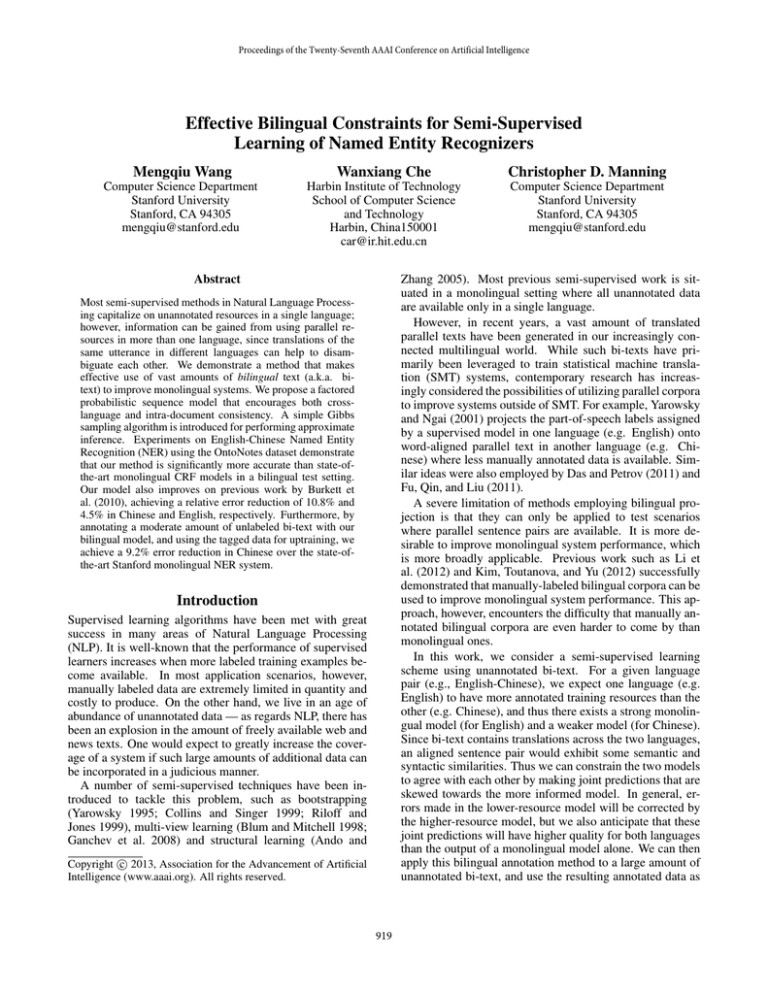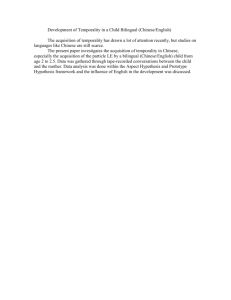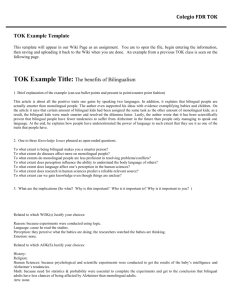
Proceedings of the Twenty-Seventh AAAI Conference on Artificial Intelligence
Effective Bilingual Constraints for Semi-Supervised
Learning of Named Entity Recognizers
Mengqiu Wang
Computer Science Department
Stanford University
Stanford, CA 94305
mengqiu@stanford.edu
Wanxiang Che
Harbin Institute of Technology
School of Computer Science
and Technology
Harbin, China150001
car@ir.hit.edu.cn
Abstract
Christopher D. Manning
Computer Science Department
Stanford University
Stanford, CA 94305
mengqiu@stanford.edu
Zhang 2005). Most previous semi-supervised work is situated in a monolingual setting where all unannotated data
are available only in a single language.
However, in recent years, a vast amount of translated
parallel texts have been generated in our increasingly connected multilingual world. While such bi-texts have primarily been leveraged to train statistical machine translation (SMT) systems, contemporary research has increasingly considered the possibilities of utilizing parallel corpora
to improve systems outside of SMT. For example, Yarowsky
and Ngai (2001) projects the part-of-speech labels assigned
by a supervised model in one language (e.g. English) onto
word-aligned parallel text in another language (e.g. Chinese) where less manually annotated data is available. Similar ideas were also employed by Das and Petrov (2011) and
Fu, Qin, and Liu (2011).
A severe limitation of methods employing bilingual projection is that they can only be applied to test scenarios
where parallel sentence pairs are available. It is more desirable to improve monolingual system performance, which
is more broadly applicable. Previous work such as Li et
al. (2012) and Kim, Toutanova, and Yu (2012) successfully
demonstrated that manually-labeled bilingual corpora can be
used to improve monolingual system performance. This approach, however, encounters the difficulty that manually annotated bilingual corpora are even harder to come by than
monolingual ones.
In this work, we consider a semi-supervised learning
scheme using unannotated bi-text. For a given language
pair (e.g., English-Chinese), we expect one language (e.g.
English) to have more annotated training resources than the
other (e.g. Chinese), and thus there exists a strong monolingual model (for English) and a weaker model (for Chinese).
Since bi-text contains translations across the two languages,
an aligned sentence pair would exhibit some semantic and
syntactic similarities. Thus we can constrain the two models
to agree with each other by making joint predictions that are
skewed towards the more informed model. In general, errors made in the lower-resource model will be corrected by
the higher-resource model, but we also anticipate that these
joint predictions will have higher quality for both languages
than the output of a monolingual model alone. We can then
apply this bilingual annotation method to a large amount of
unannotated bi-text, and use the resulting annotated data as
Most semi-supervised methods in Natural Language Processing capitalize on unannotated resources in a single language;
however, information can be gained from using parallel resources in more than one language, since translations of the
same utterance in different languages can help to disambiguate each other. We demonstrate a method that makes
effective use of vast amounts of bilingual text (a.k.a. bitext) to improve monolingual systems. We propose a factored
probabilistic sequence model that encourages both crosslanguage and intra-document consistency. A simple Gibbs
sampling algorithm is introduced for performing approximate
inference. Experiments on English-Chinese Named Entity
Recognition (NER) using the OntoNotes dataset demonstrate
that our method is significantly more accurate than state-ofthe-art monolingual CRF models in a bilingual test setting.
Our model also improves on previous work by Burkett et
al. (2010), achieving a relative error reduction of 10.8% and
4.5% in Chinese and English, respectively. Furthermore, by
annotating a moderate amount of unlabeled bi-text with our
bilingual model, and using the tagged data for uptraining, we
achieve a 9.2% error reduction in Chinese over the state-ofthe-art Stanford monolingual NER system.
Introduction
Supervised learning algorithms have been met with great
success in many areas of Natural Language Processing
(NLP). It is well-known that the performance of supervised
learners increases when more labeled training examples become available. In most application scenarios, however,
manually labeled data are extremely limited in quantity and
costly to produce. On the other hand, we live in an age of
abundance of unannotated data — as regards NLP, there has
been an explosion in the amount of freely available web and
news texts. One would expect to greatly increase the coverage of a system if such large amounts of additional data can
be incorporated in a judicious manner.
A number of semi-supervised techniques have been introduced to tackle this problem, such as bootstrapping
(Yarowsky 1995; Collins and Singer 1999; Riloff and
Jones 1999), multi-view learning (Blum and Mitchell 1998;
Ganchev et al. 2008) and structural learning (Ando and
Copyright c 2013, Association for the Advancement of Artificial
Intelligence (www.aaai.org). All rights reserved.
919
ViceO ForeignB-ORG A↵airsI-ORG MinisterO HuaqiuB-PER LiuI-PER heldO talksO withO KamyaoB-PER
§ËB-ORG
oËO
⇠NÀB-PER
O
†seB-PER
>LO
ÜO
⇢
O
Figure 1: Example of NER labels between two word-aligned bilingual parallel sentences.
additional training data to train a new monolingual model
with better coverage.1
Burkett et al. (2010) proposed a similar framework with
a “multi-view” learning scheme where k-best outputs of
two monolingual taggers are reranked using a complex selftrained reranking model. In our work, we propose a simple decoding method based on Gibbs sampling that eliminates the need for training complex reranking models. In
particular, we construct a new factored probabilistic model
by chaining together two Conditional Random Field monolingual models with a bilingual constraint model, which encourages soft label agreements. We then apply Gibbs sampling to find the best labels under the new factored model.
We can further improve the quality of bilingual prediction by
incorporating an additional model, expanding upon Finkel,
Grenager, and Manning (2005), that enforces global label
consistency for each language.
Experiments on Named Entity Recognition (NER) show
that our bilingual method yields significant improvements
over the state-of-the-art Stanford NER system. When evaluated over the standard OntoNotes English-Chinese dataset
in a bilingual setting, our models achieve a F1 error reduction of 18.6% in Chinese and 9.9% in English. Our
method also improves over Burkett et al. (2010) with a relative error reduction of 10.8% and 4.5% in Chinese and English, respectively. Furthermore, we automatically label a
moderate-sized set of 80k sentence pairs using our bilingual
model, and train new monolingual models using an uptraining scheme. The resulting monolingual models demonstrate
an error reduction of 9.2% over the Stanford NER systems
for Chinese.2
marked with tag O are not part of any entity. Figure 1 illustrates a tagged sentence pair in English and Chinese.
Current state-of-the-art supervised NER systems employ
an undirected graphical model called Conditional Random
Field (CRF) (Lafferty, McCallum, and Pereira 2001). Given
an input sentence x, a linear-chain structured CRF defines
the following conditional probability for tag sequence y:
X
1 Y
Pmono (y|x) =
exp(
j fj (yi , yi 1 |x)) (1)
Z(x) i
j
where fj is the jth feature function,
and Z(x) is the partition function.
j
is the feature weight,
Bilingual NER Constraints
A pair of aligned sentences in two languages contain complementary cues to aid the analysis of each other. For example, in Figure 1, it is not immediately obvious whether the
phrase “Foreign Affairs” on the English side refers to an organization (Ministry of Foreign Affairs), or general foreign
affairs. But the aligned word on the Chinese side is a lot less
ambiguous, and can be easily identified as an organization
entity.
Another example is that in the Chinese training data we
have never seen the translation of the name “Kamyao”. As a
result, the tagger cannot make use of lexical features, and so
has to rely on less informative contextual features to predict
if it is a geo-political entity (GPE) or a person. But we have
seen the aligned word on the English side being tagged as
person, and thus can infer that the Chinese aligned entity
should also be a person.
It is straight-forward to see that accurate word alignment
is essential in such an analysis. Fortunately, there are automatic word alignment systems used in MT research that produce robust and accurate alignment results, and our method
will use the output of one (Liang, Taskar, and Klein 2006).
Monolingual NER with CRF
Named Entity Recognition is an important task in NLP. It
serves as a first step in turning unstructured text into structured data, and has broad applications in news aggregation,
question answering, and bioNLP. Given an input sentence,
an NER tagger identifies words that are part of a named entity, and assigns the entity type and relative position information. For example, in the commonly used BIO tagging
scheme, a tag such as B-PERSON indicates the word is the
beginning of a person name entity; and a I-LOCATION tag
marks the word to be inside a location entity. All words
Hard Agreement Constraints
Drawing on the above observations, we first propose a simple bilingual constraint model that enforces hard agreements.
We define the following probability for an output sequence pair yc and ye for Chinese and English input sentences xc and xe , respectively:
Y
Pbi (yc , ye ) =
(yac , yae )
(2)
1
This training regimen is also referred to as “uptraining”
(Petrov et al. 2010).
2
All of our code is made available at nlp.stanford.edu/software/
A={ac ,ae }
CRF-NER.shtml.
920
...
...
consider the joint probability of an output sequence pair in a
bilingual setting, especially when we apply the aforementioned bilingual constraints, cyclic cliques are introduced
into the Markov random field which make exact inference
algorithms intractable.
Markov Chain Monte Carlo (MCMC) methods offer a
simple and elegant solution for approximate inference by
constructing a Markov chain whose stationary distribution
is the target distribution.
In this work, we adopt a specific MCMC sampling
method called Gibbs sampling (Geman and Geman 1984).
We define a Markov chain over output sequences by observing a simple transition rule: from a current sequence assignment at time t 1, we can transition into the next sequence
at time t by changing the label at any position i. And the
distribution over these transitions is defined as:
theO earliestO establishedO bondedO areaO
ÈO
ûO
ÑO
› :B-LOC
Figure 2: Example of annotation standard inconsistency
where A is the set of all aligned word pairs, and (yac , yae )
is an indicator function that equals 1 if yac = yae , and 0
otherwise.
Soft Agreement Constraints
If we apply hard agreement constraints, any output sequence
pairs that disagree on any tag pair will be assigned zero probability. Such a hard constraint is not always satisfied in practice, since annotation standards in different languages can
differ. An example is given in Figure 2, where the phrase
mention of “bonded area” is considered a location in the
Chinese gold-standard, but not in the English gold-standard.
We can soften these constraints by replacing the 1 and
0 values in indicator function (yac , yae ) with a probability
measure. We first tag a set of unannotated bilingual sentence
pairs using two baseline monolingual CRF taggers. Then
we collect counts of aligned entity tag pairs from the autogenerated tagged data. The value (yac , yae ) is chosen to
be the pairwise mutual information score of the entity pair
(yac , yae ). This version of constraints is denoted as auto.
P (yt |yt
1
) = P (yit |yt
1
i
, x)
(3)
where yt i 1 is the set of all labels except yi at time t 1.
To apply the bilingual constraints during decoding, we
formulate a new factored model by combining the two
monolingual CRF models (one for each language) with the
bilingual constraint model via a simple product.3 The resulting model is of the following form:
P (yc , ye |xc , xe ) = Pmono (yc |xc )Pmono (ye |xe )Pbi (yc , ye )
(4)
Obtaining the state transition model P (yit |yt i 1 , x) for the
monolingual CRF models is straight-forward. In the case
of a first order linear-chain CRF, the Markov blanket is the
neighboring two cliques. Given the Markov blanket of state
i, the label at position i is independent of all other states.
Thus we can compute the transition model simply by normalizing the product of the neighboring clique potentials.
Finkel, Grenager, and Manning (2005) gave a more detailed
account of how to compute this quantity.
The transition probabilityQof label yc i in the bilingual constraint model is defined as (yc i ,ye k )2A (yc i , ye k ), where
ye k is a word aligned to yc i .
At decoding time, we walk the Markov chain by taking
samples at each step. We start from some random assignment of the label sequence, and at each step we randomly
sample a new value for yi at a randomly chosen position
i. After a fixed number of steps, we output a complete sequence as our final solution. In practice, MCMC sampling
could be quite slow and inefficient, especially when the input sentence is long. To speed up the sampling process, we
initialize the state sequence from the best sequences found
by Viterbi decoding using only the monolingual models.
A bigger problem with vanilla Gibbs sampling is that the
random samples we draw do not necessarily give us the most
likely state sequence, as given by Viterbi in the exact inference case. One way to tackle this problem is to borrow the
simulated annealing technique from optimization research
Alignment Uncertainty
When we consider the previous two sets of bilingual constraints, we assume the word alignments are given by some
off-the-shelf alignment model which outputs a set of “hard”
alignments. In practice, most statistical word alignment
models assign a probability to each alignment pair, and
“hard” alignments are produced by cutting off alignment
pairs that fall below a threshold value.
To take into account alignment uncertainties, we modify function (yac , yae ) by exponentiating its value to the
power of the alignment probability to give a new function:
(yac , yae ) = (yac , yae )P(yac ,yae ) . The intuition behind
this modification is that pairs with a higher alignment probability will reflect more probability fluctuation when different
label assignments are considered.
For example, consider an extreme case where a particular
pair of aligned words has alignment probability 0. Then the
value of the function will always be 1 regardless of what
tags are assigned to the two words, thus reducing the impact
of different choices of tags for this pair in the overall tag
sequence assignment.
Gibbs Sampling with Factored Models
In a monolingual setting, exact inference in a standard
linear-chain CRF can be done by applying the Viterbi algorithm to find the most likely output sequence. But when we
3
This model double-counts the state sequence conditioned on a
given observation, and therefore is likely deficient. However, we
do not find this to be a problem in practice.
921
Chinese NER Templates
00: 1 (class bias param)
01: wi+k , 1 k 1
02: wi+k 1 wi+k , 0 k 1
03: shape(wi+k ), 4 k 4
04: prefix(wi , k), 1 k 4
05: prefix(wi 1 , k), 1 k 4
06: suffix(wi , k), 1 k 4
07: suffix(wi 1 , k), 1 k 4
08: radical(wi , k), 1 k len(wi )
09: distsim(wi+k ), 1 k 1
Unigram Features
yi 00 – 09
Bigram Features
yi 1 yi 00 – 09
(Kirkpatrick, Gelatt, and Vecchi 1983). We redefine the transition probability in Eqn. 3 as:
P (yt |yt
1
P (y t |yt 1 , x)1/ct
) = P i t it 1 1/c
t
j P (yj |y j , x)
(5)
where c = {c0 . . . cT } is the schedule of annealing “temperature,” with 0 ci 1. The distribution becomes
sharper as the value of ci move towards 0. In our experiments we adopted a linear cooling schedule, where c0 = 1,
and ct+1 = ct 1/T . This technique has been shown to be
effective by Finkel, Grenager, and Manning (2005).
Global Consistency Constraints
Table 1: Basic features of Chinese NER. means string concatenation and yi is the named entity label of the ith word
wi . shape(wi ) is the shape of wi , such as date and number.
prefix/suffix(wi , k) denotes the k-characters prefix/suffix of
wi . radical(wi , k) denotes the radical of the k th Chinese
character of wi .4 len(wi ) is the number of Chinese characters in wi . distsim(wi , k) denotes the distributional similarity features based on large word clusters.
A distinctive feature of the proposed factored model and
Gibbs sampling inference is the ability to incorporate nonlocal constraints that are not easily captured in a traditional
Markov network model. The bilingual constraint model described earlier is certainly a benefactor of this unique characteristic.
Still, there are further linguistic constraints that we can
apply to improve the NER system. For example, many previous papers have made the observation that occurrences of
the same word sequence within a given document are unlikely to take on different entity types (Bunescu and Mooney
2004; Sutton and McCallum 2004; Finkel, Grenager, and
Manning 2005; inter alia) . Similar to Finkel, Grenager, and
Manning (2005), we devise a global consistency model as
follows:
Y
#( ,y,x)
Pglo (y|x) =
(6)
which has value > 0.
is activated each time we see a
matching pair of entities for the same word occurrence. The
new Pglo is modified as:
Y
#( ,y,x)
(7)
Pglo (y|x) = #( ,y,x)
2
where #( , y, x) is the activation count of in sequence y.
This model is in fact a naive Bayes model, where the parameters and are empirically estimated (a value of 2 is
used for in our experiments, based on tuning on a development set). A similar global consistency model was shown
to be effective in Rush et al. (2012), where parameters were
also tuned on a development set.
2
is the set of all possible entity type violations,
is the
penalty parameter for violation type , and #( , y, x) is
the count of violations in sequence y. For example, if
the word sequence “China Daily” has occurred both as GPE
and organization exactly once, then the penalty
for GPEto-organization violation will apply once. The parameter
values of
are estimated empirically by counting the occurrences of entity pairs of the same word sequence in the
training data.
We can now factor in one global consistency model for
each language by taking the product of Eqn. 4 with Eqn. 6.
The same Gibbs sampling procedure applies unchanged to
this new factored model. At test time, instead of tagging one
sentence at a time, we group together sentences that belong
to the same document, and tag one document at a time.
Experimental Setup
To compare the proposed bilingual constraint decoding algorithm against traditional monolingual methods, we evaluate
on a large, manually annotated parallel corpus that contains
named entity annotation in both Chinese and English. The
corpus we use is the latest version (v4.0) of the OntoNotes
corpus (Hovy et al. 2006), which includes 401 pairs of Chinese and English documents (chtb 0001-0325, ectb 10011078). We use odd-numbered documents as the development set and even-numbered documents as the blind test set.
These document pairs are aligned at document level, but
not at sentence or word level. To obtain sentence alignment,
we use the Champollion Tool Kit (CTK).5 After discarding
sentences with no aligned counterpart, a total of 8,249 sentence pairs were retained. We induce word alignment using the BerkeleyAligner toolkit (Liang, Taskar, and Klein
Enhancing Recall
A flaw of the Finkel, Grenager, and Manning (2005) model
described above is that consistency is enforced by applying
penalties to entity type violations. But if a word is not tagged
with an entity type, it will not receive any penalty since no
entity type violations would occur. Therefore, this model
has the tendency of favoring null annotations, which can result in losses in model recall.
We fix this deficiency in Finkel, Grenager, and Manning (2005) by introducing a new “reward” parameter ,
4
5
922
www.unicode.org/charts/unihan.html
champollion.sourceforge.net
2006).6 The aligner outputs the posterior probability for
each aligned word pair. To increase efficiency, we prune
away all alignments that have probability less than 0.1.
We adopt the state-of-the-art monolingual Stanford NER
tagger as a strong baseline for both English and Chinese.
For English, we use the default tagger setting from Finkel,
Grenager, and Manning (2005). For Chinese, we use an
improved set of features over the default tagger, which are
listed in Table 1. Both models make use of distributional
similarity features taken from word clusters trained on large
amounts of non-overlapping data. We train the two CRF
models on all portions of the OntoNotes corpus that are annotated with named entity tags, except the parallel-aligned
portion which we reserve for development and test purposes.
In total, there are about 660 documents (⇠16k sentences)
and 1,400 documents (⇠39k sentences) for Chinese and English, respectively.
Out of the 18 named entity types that are annotated in
OntoNotes, which include person, location, date, money,
and so on, we select the four most commonly seen named
entity types for evaluation. They are person, location, organization and GPE. All entities of these four types are converted to the standard BIO format, and background tokens
and all other entities types are marked with tag O.
In all of the Gibbs sampling experiments, a fixed number of 2000 sampling steps are taken, and a linear cooling
schedule is used in the deterministic annealing procedure.
In order to compare our method with past work, we obtained code from Burkett et al. (2010) and reproduced their
experiment setting for the OntoNotes data. An extra set of
5,000 unannotated parallel sentence pairs are used for training the reranker, and the reranker model selection was performed on the development dataset.
We report standard NER measures (entity precision (P),
recall (R) and F1 score) on the test set. Statistical significance tests are done using the paired bootstrap resampling
method (Efron and Tibshirani 1993), where we repeatedly
draw random samples with replacement from the output of
the two systems, and compare the test statistics (e.g. absolute difference in F1 score) of the new samples with the
observed test statistics. We used 1000 sampling iterations in
our experiments.
CRF
Burkett
hard
manual
auto
auto+aP
Chinese
R
61.64
65.84
64.47
65.85
66.90
68.46
F1
68.42
71.20
69.84
72.24
72.25
73.43
P
81.98
82.28
82.13
82.87
82.11
82.05
English
R
74.59
76.64
72.85
74.56
75.40
75.56
F1
78.11
79.36
77.21
78.50
78.62
78.67
Table 2: Results on bilingual parallel test set. F1 scores that
are statistically significantly better than the CRF baseline is
highlighted in bold.
0.9% drop on the English side. The tradeoff mainly occurs
in recall.
When we loosen the bilingual constraint to allow softagreement by simply assigning a hand-picked value (0.02)
to aligned entities of different types (row manual), we observe a significant increase in accuracy in both Chinese and
English. This suggests that the soft alignment successfully
accounted for the cases where annotation standards differ
in the two languages. In particular, the Chinese results are
3.8% better than the monolingual baseline, a 12% relative
error reduction.
When we replace the arbitrary hand-picked softagreement probabilities with empirical counts from the autotagged dataset (row auto), we see a small increase in recall
on both sides, but a drop in precision for Chinese. However, accounting for alignment uncertainty (row auto+aP)
increases both precision and recall for Chinese, resulting in
another 1.2% increase in absolute F1 score over the auto
model.
Comparing against Burkett et al. (2010) (second row from
the top), we can see that both our method and Burkett et
al. (2010) significantly outperform the monolingual CRF
baseline. This suggests that methods that explore bilingual
language cues do have great utility in the NER task. Our
best model (auto+aP) gives a significant gain over Burkett et al. (2010) on Chinese (by 2.2%), but trails behind on
English by 0.7%. However, we will show in the next section some further improvements to our method by modeling
global label consistency, which allows us to outperform Burkett et al. (2010) on both languages.
Bilingual NER Results
Results on Global Consistency
The main results on Chinese and English test sets are shown
in Table 2. The first row (CRF) shows the baseline monolingual model performance. As we can see, the performance on
Chinese is much lower than on English. This is partially attributed to the fact that the Chinese NER tagger was trained
on less than half as much data, but it is also because NER
in Chinese is a harder problem (e.g., there are no capitalization features in Chinese, which is a very strong indicator of
named entities in English).
By enforcing hard agreement constraints, we can see from
row hard that there is an increase of about 1.4% in absolute F1 score on the Chinese side, but at the expense of a
6
P
76.89
77.52
76.19
80.02
78.53
79.17
Table 3 shows results on the test set after factoring in a
global consistency model. Adding global consistency to the
monolingual baseline (mono) increases performance on English (consistent with results from previous work (Finkel,
Grenager, and Manning 2005)), but hurts Chinese results,
especially in recall.
A possible explanation is that CRF models for English
are more certain about which words are entities (by having
strong indicative features such as word capitalization), and
thus a penalty does not persuade the model to label a word as
a non-entity. However, in the Chinese case, the CRF model
is weaker, and thus less certain about words being an entity or not. It is also much more likely that the same word
code.google.com/p/berkeleyaligner
923
mono
+global
+global’
auto
+global
+global’
auto+aP
+global
+global’
P
76.89
77.30
75.23
78.53
79.02
76.17
79.17
79.31
76.43
Chinese
R
61.64
58.96
68.12
66.90
64.57
71.04
68.46
65.93
72.32
F1
68.42
66.90
71.50
72.25
71.07
73.52
73.43
72.01
74.32
P
81.98
83.89
82.31
82.11
84.02
82.87
82.05
84.01
82.30
English
R
74.59
74.88
77.63
75.40
75.73
78.84
75.56
75.81
78.35
Method
CRF baseline
Self-training
Semi with Burkett
Semi with auto+aP
F1
78.11
79.13
79.90
78.62
79.66
80.81
78.67
79.70
80.28
# train sent
⇠16k
+80k
+80k
+80k
+40k
+10k
P
76.89
75.15
76.30
77.40
76.97
77.48
R
61.64
59.06
63.46
66.10
65.60
64.95
F1
68.42
66.14
69.29
71.31
70.83
70.66
Table 4: Semi-supervised results on Chinese test set. F1
scores that are statistically significantly better than the CRF
baseline is highlighted in bold.
Table 3: Results of enforcing global consistency. global
is the global consistency without “reward” parameter, and
global’ is the one with “reward” parameter. “mono” is the
monolingual CRF baseline. Best number in each column is
highlighted in bold.
Therefore, in order to benefit general monolingual NLP systems, we propose a semi-supervised learning setting where
we use the bilingual tagger to annotate a large amount of
unannotated bilingual text, then we take the tagged sentences on the Chinese side to retrain a monolingual Chinese
tagger.
To evaluate the effectiveness of this approach, we used the
Chinese-English part of the Foreign Broadcast Information
Service corpus (FBIS, LDC2003E14), and tagged it with the
auto+aP model. Unlike the OntoNotes dataset, this corpus
does not contain document boundaries. In order to apply
the document-level label consistency model, we divide the
test set into blocks of ten sentences, and use the blocks as
pseudo-documents.
Results from self-training, as well as results from uptraining using model outputs from Burkett et al. (2010) are shown
in Table 4. We can see that by using 80,000 additional sentences, our method gives a significant boost (⇠2.9%, an error reduction of ⇠9.2%) over the CRF baseline. Our method
also improves over Burkett et al. (2010) by a significant margin.
The gains are more pronounced in recall than precision,
which suggests that the semi-supervised approach using
bilingual data is very effective in increasing the coverage
of the monolingual tagger. On the other hand, monolingual
self-training hurts performance in both precision and recall.
We also report results on the effect of using increasing
amounts of unannotated bilingual data. When only 10k sentences are added to the Chinese side, we already see a 5.2%
error reduction over the CRF baseline.
(string) will be both an entity and a common word in Chinese than English. In some cases, the model will be better
off marking a word as a non-entity, than risking taking a
penalty for labeling it inconsistently. By applying the “reward” function, we see a drastic increase in recall on both
Chinese and English, with a relatively small sacrifice in precision on Chinese. The overall F1 score increases by about
3.1% and 0.8% in Chinese and English, respectively.
Similar results can be found when we apply global consistency to the bilingual model (auto). Again we see a
recall-precision tradeoff between models with or without a
“reward” function. But overall, we observe a significant increase in performance when global consistency with a reward function is factored in.
Modeling alignment uncertainty continues to improve the
Chinese results when the global consistency model is added,
but shows a small performance decrease on the English side.
But the gain on the Chinese side is more significant than the
loss on English side.
The best overall F1 scores are achieved when bilingual
constraints, global consistency with reward, and alignment
uncertainty are conjoined. The combined model outperforms the CRF monolingual baseline, with an error reduction of 18.6% for Chinese and 9.9% for English. This model
also significantly improves over the method of Burkett et
al. (2010) with an error reduction of 10.8% for Chinese and
4.5% for English.
Beyond the difference in model performance, our method
is much easier to understand and implement than Burkett et
al. (2010). Their method involves simulating a multi-view
learning environment using “weakened” monolingual models to train a reranking model, and transplanting the parameters of the “weakened” models to “strong” models at test
time in a practical but ad-hoc manner.
Conclusions
We introduced a factored model with a Gibbs sampling inference algorithm, that can be used to produce more accurate
tagging results for a parallel corpus. Our model makes use
of cross-language bilingual constraints and intra-document
consistency constraints. We further demonstrated that unlabeled parallel corpora tagged with our bilingual model can
then be used to improve monolingual tagging results, using
an uptraining scheme. The model presented here is not restricted to the NER task only, but can be adopted to improve
other natural language applications as well, such as syntactic
parsing and semantic analysis.
Semi-supervised NER Results
In the previous section we demonstrated the utility of our
proposed method in a bilingual setting, where parallel sentence pairs are tagged together and directly evaluated. In reality, this is not the common use case. Most down-stream
NLP applications operate in a monolingual environment.
924
Acknowledgments
Kim, S.; Toutanova, K.; and Yu, H. 2012. Multilingual
named entity recognition using parallel data and metadata
from wikipedia. In Proceedings of ACL.
Kirkpatrick, S.; Gelatt, C. D.; and Vecchi, M. P. 1983. Optimization by simulated annealing. Science 220:671–680.
Lafferty, J. D.; McCallum, A.; and Pereira, F. C. N. 2001.
Conditional random fields: Probabilistic models for segmenting and labeling sequence data. In Proceedings of
ICML.
Li, Q.; Li, H.; Ji, H.; Wang, W.; Zheng, J.; and Huang, F.
2012. Joint bilingual name tagging for parallel corpora. In
Proceedings of CIKM.
Liang, P.; Taskar, B.; and Klein, D. 2006. Alignment by
agreement. In Proceedings of HLT-NAACL.
Petrov, S.; Chang, P.-C.; Ringgaard, M.; and Alshawi, H.
2010. Uptraining for accurate deterministic question parsing. In Proceedings of EMNLP.
Riloff, E., and Jones, R. 1999. Learning dictionaries for
information extraction by multi-level bootstrapping. In Proceedings of AAAI.
Rush, A. M.; Reichert, R.; Collins, M.; and Globerson,
A. 2012. Improved parsing and POS tagging using
inter-sentence consistency constraints. In Proceedings of
EMNLP.
Sutton, C., and McCallum, A. 2004. Collective segmentation and labeling of distant entities in information extraction.
In Proceedings of ICML Workshop on Statistical Relational
Learning and Its connections to Other Fields.
Yarowsky, D., and Ngai, G. 2001. Inducing multilingual
POS taggers and NP brackets via robust projection across
aligned corpora. In Proceedings of NAACL.
Yarowsky, D. 1995. Unsupervised word sense disambiguation rivaling supervised methods. In Proceedings of ACL.
The authors would like to thank Rob Voigt and the four
anonymous reviewers for their valuable comments and suggestions. We gratefully acknowledge the support of the
National Natural Science Foundation of China (NSFC)
via grant 61133012, the National “863” Project via grant
2011AA01A207 and 2012AA011102, the Ministry of Education Research of Social Sciences Youth funded projects
via grant 12YJCZH304, the Defense Advanced Research
Projects Agency (DARPA) Machine Reading Program under
Air Force Research Laboratory (AFRL) prime contract no.
FA8750-09-C-0181 and the support of the DARPA Broad
Operational Language Translation (BOLT) program through
IBM.
Any opinions, findings, and conclusion or recommendations expressed in this material are those of the authors and
do not necessarily reflect the view of the DARPA, AFRL, or
the US government.
References
Ando, R. K., and Zhang, T. 2005. A high-performance
semi-supervised learning method for text chunking. In Proceedings of ACL.
Blum, A., and Mitchell, T. 1998. Combining labeled and
unlabeled data with co-training. In Proceedings of COLT.
Bunescu, R., and Mooney, R. J. 2004. Collective information extraction with relational markov networks. In Proceedings of ACL.
Burkett, D.; Petrov, S.; Blitzer, J.; and Klein, D. 2010.
Learning better monolingual models with unannotated bilingual text. In Proceedings of CoNLL.
Collins, M., and Singer, Y. 1999. Unsupervised models for
named entity classification. In Proceedings of EMNLP.
Das, D., and Petrov, S. 2011. Unsupervised part-of-speech
tagging with bilingual graph-based projections. In Proceedings of ACL.
Efron, B., and Tibshirani, R. J. 1993. An Introduction to the
Bootstrap. New York: Chapman & Hall.
Finkel, J. R.; Grenager, T.; and Manning, C. 2005. Incorporating non-local information into information extraction
systems by gibbs sampling. In Proceedings of ACL.
Fu, R.; Qin, B.; and Liu, T. 2011. Generating chinese named
entity data from a parallel corpus. In Proceedings of IJCNLP.
Ganchev, K.; Graca, J.; Blitzer, J.; and Taskar, B. 2008.
Multi-view learning over structured and non-identical outputs. In Proceedings of UAI.
Geman, S., and Geman, D. 1984. Stochastic relaxation,
Gibbs distributions, and the Bayesian restoration of images.
IEEE Transitions on Pattern Analysis and Machine Intelligence 6:721–741.
Hovy, E.; Marcus, M.; Palmer, M.; Ramshaw, L.; and
Weischedel, R. 2006. Ontonotes: the 90% solution. In
Proceedings of NAACL-HLT.
925






